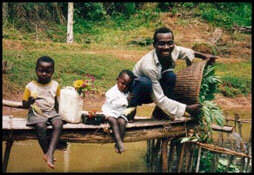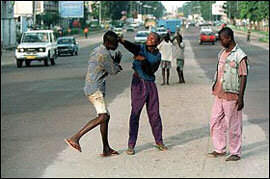 PEOPLE PEOPLE |

We had the chance and the privilege to share part of our lives with Congolese and we will never forget the values of simplicity and plainness of this people and, over all, their warm, open and bright smiles.
 HUMAN ORIGINS HUMAN ORIGINS
Equatorial Africa has been inhabited since at least the middle Stone Age. Late Stone Age cultures flourished in the southern savanna after ca. 10,000 B.C. and remained viable until the arrival of Bantu-speaking peoples during the first millennium B.C. Evidence suggests that these Stone Age populations lived in small groups, relying for subsistence on hunting and gathering. Some of these groups may have remained long enough in one vicinity to be considered permanent residents, but others moved, following game along the extensive river network and through the rainforest.
The development of food-producing communities in Equatorial Africa is associated with the expansion of Bantu speaking peoples. In a long series of migrations beginning ca. 1,000 B.C. and lasting well into the mid-first millennium A.D., Bantu speakers dispersed from a point west of the Ubangi-congo River swamp across the forests and savannas of modern DRC. A northern group moved northeastward around the swamp and across the northern regions of DRC and settled in the forest zone. Meanwhile, other groups moved south and southwest, the former then migrating up the congo as well as into the inner part of the congo basin, while the southwestern Bantu speakers spread into modern Gabon, Congo, and lower DRC.
It was apparently after these movements that Bantu speakers spread south and southeastward across the southern Congolese savanna as far as present-day Angola and Zambia, thereafter continuing to expand into eastern and southern Africa. These migrating groups generally brought with them a technology superior to that of the existing inhabitants. The Bantu speakers were better able to exploit an area's resources through the practice of agriculture, based on yam and oil palm cultivation, and, as time went on, by adopting iron tools and technology.
Bantu-speaking peoples settled in the rain forests and southern savannas. Non-Bantu-speaking peoples are found in the grasslands north of the forest. Information on the settlement dates and routes of migration of these peoples remains vague at best, but they seem to have dwelt at first in the northern grasslands and only later penetrated the forest. Since perhaps late in the first millennium B.C., they have intermingled with the Bantu-speaking groups who preceded them, creating in the process a complex ethnic mosaic.
The significance of some of these peoples extends beyond purely linguistic considerations. The peoples speaking Central Sudanic languages brought with them a new food complex involving cereal cultivation and herding. A related food pattern based on cereals and hunting was separately introduced to southeastern DRC from East Africa after ca. A.D. 100. Cereal cultivation, hunting, and herding were much better adapted to conditions in the savannas than the oil palm and yam farming that the Bantu speakers had brought from western Africa, and, hence, spread rapidly, especially in the southern grasslands. The banana, another important food crop, was introduced, apparently, from southern Asia into East Africa in the early centuries of the present era and thereafter diffused across Central Africa.
These new food sources allowed for greater settlement and population growth in the grasslands; they also contributed in no small way to the growth of trade and to increasingly complex social and political organization among those peoples who dwelt in the savannas.
 ETHNIC GROUPS ETHNIC GROUPS
DRC's population is composed of as many as 250 different ethnic groups, most of which are Bantu-speakers. The largest Bantu speaking groups are the Luba, Kongo, Mongo, and Lunda. In 1992 some sources reported that the Luba, Kongo, and Mongo groups as well as the non-Bantu speaking Mangbetu-Azande together made up about 45 percent of the population. Calculations of the number and relative sizes of ethnic groups in DRC are at best approximations, however.
These groups are neither fixed entities nor the sole or even primary points of reference for all Congolese. On the contrary, for most purposes and in most contexts, rural Congolese see themselves primarily as members of a local community or of a clan or lineage. Ethnic identity has become salient only under certain conditions, and the precise boundaries of ethnic groups have shifted with circumstances. Ethnicity and regionalism (the latter based in part on ethnic considerations) were, and continue to be, of substantial importance in the political orientation of Congolese, but the units involved have always varied in composition, cohesion, and ideological selfconsciousness.
 LANGUAGES LANGUAGES
French, is the official language used for social and trade exchange, there are four national vehicular languages which are: the swaili mainly spoken in the principal cities and overall at the east, the kinkango in the Congo slums, the tshilouba in the south, and the lingla in Kinshasa and in zaïre, there are also numerous bantu languages spoken, nilo-hamitic and Soudanese. |  EDUCATION EDUCATION
Before independence, education was largely in the hands of religious groups. The primary school system was well-developed at independence; however, the secondary school system was limited, and higher education was almost nonexistent in most regions of the country. The principal objective of this system was to train low-level administrators and clerks. Since independence, efforts have been made to increase access to education, and secondary and higher education have been made available to many more Congolese. Despite the deterioration of the state-run educational system in recent years, about 80% of the males and 65% of females, ages 6-11, were enrolled in a mixture of state and church run primary schools in 1996. At higher levels of education, males greatly outnumber females. The elite continues to send their children abroad to be educated, primarily in Western Europe.
 CONGOLESE POPULATION IN FACTS CONGOLESE POPULATION IN FACTS

Population: 53,624,718
note: estimates for this country explicitly take into account the effects of excess mortality due to AIDS; this can result in lower life expectancy, higher infant mortality and death rates, lower population and growth rates, and changes in the distribution of population by age and sex than would otherwise be expected (July 2001 est.).
Age structure:
0-14 years: 48% (male 12,597,444; female 12,490,279)
15-64 years: 49% (male 12,503,440; female 13,037,527)
65 years and over: 3% (male 567,823; female 768,486) (2000 est.)
Population growth rate: 3.19% (2000 est.)
Birth rate: 46.44 births/1,000 population (2000 est.)
Death rate: 15.38 deaths/1,000 population (2000 est.)
Net migration rate: 0.82 migrant(s)/1,000 population (2000 est.)
note: in 1994, about a million refugees fled into DRC, to escape the fighting between the Hutus and the Tutsis in Rwanda and Burundi; the outbreak of widespread fighting in the DRC between rebels and government forces in October 1996 spurred about 875,000 refugees to return to Rwanda in late 1996 and early 1997; an additional 173,000 Rwandan refugees disappeared in early 1997 and are assumed to have been killed by DRC forces; fighting was renewed in August 1998 and has continued sporadically into 2000 resulting in further internal displacement and refugee movements within the Great Lakes region.
Sex ratio:
at birth: 1.03 male(s)/female
under 15 years: 1.01 male(s)/female
15-64 years: 0.96 male(s)/female
65 years and over: 0.74 male(s)/female
total population: 0.98 male(s)/female (2000 est.)
Infant mortality rate: 101.71 deaths/1,000 live births (2000 est.)

Life expectancy at birth:
total population: 48.75 years
male: 46.72 years
female: 50.83 years (2000 est.)
Total fertility rate: 6.92 children born/woman (2000 est.)
Nationality:
noun: Congolese (singular and plural)
adjective: Congolese or Congo
Ethnic groups: over 200 African ethnic groups of which the majority are Bantu; the four largest tribes Mongo, Luba, Kongo (all Bantu), and the Mangbetu-Azande (Hamitic) make up about 45% of the population
Religions: Roman Catholic 50%, Protestant 20%, Kimbanguist 10%, Muslim 10%, other syncretic sects and indigenous beliefs 10%
Literacy:
definition: age 15 and over can read and write French, Lingala, Kingwana, or Tshiluba
total population: 77.3%
male: 86.6%
female: 67.7% (1995 est.)
|

